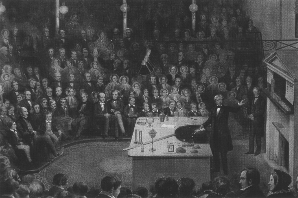
Natural Science - Year II
Unit 39: Search for the Elements

History Weblecture for Unit 39
| This Unit's | Homework Page | History Lecture | Science Lecture | Lab | Parents' Notes |
History Lecture for Unit 39: Search for the Elements
For Class
- Period: 1750-1800
For the interactive timelines, click on an image to bring it into focus and read notes.
Click on the icon to bring up the timeline in a separate browser window. You can then resize the window to make it easier to read the information.Click here: Timeline PDF to bring up the timeline as a PDF document. You can then click on the individual events to see more information if you want. Exploring this version of the timeline is optional!
- Geographic Location: Western Europe
- People to know: Amadeus Avogadro, Dmitri Mendeleev
- See science topics: Chemistry
Outline/Summary
Modern Chemistry: Atomic Theory
Check the History of Discovery site to determine when different elements were isolated and named. None of the elements were recognized as modern elements until Lavoisier and Dalton began their work; Aristotle would have explained gold as fire and earth combined.
The Eighteenth Century Chemists after Dalton
The French chemist Joseph Guy-Lussac, following Dalton's work, showed that volumes of gases combine in whole number ratios: one volume of nitrogen combines with three volumes of hydrogen to form two volumes of ammonia gas, for example. Amedeo Avogadro, an Italian, took this concept further, and published a theory in 1811 that if there were such a simple numerical relationship between the volumes of the combining gases and their products, there must be a simple connection between the actual numbers of particles in equal volumes of the gas. He proposed that these particles (which could be made of compounds of individual atoms) be called molecules, or little masses. Then equal volumes of gases under the same conditions of temperature and pressure would contain the same number of molecules.
Avogadro's proposal was not particularly well received by his contemporaries, however; his work remained obscure and unused for nearly half a century, until it was rediscovered and used in the 1860s, after Avogadro's death. The chemists of the period did honor Avogadro by naming a physical constant for him. Avogadro's number, 6.02 * 1023, is the number of molecules or atoms in a mole of substance, where a mole is equal to the gram weight matching the atomic weight of an element. For example, the atomic weight of hydrogen is one; so one gram of hydrogen has one mole of hydrogen molecules. The atomic weight of oxygen is eight, so eight grams of oxygen contain one mole of oxygen atoms. One gram of hydrogen gas 6.02 * 1023 hydrogen atoms in it; eight grams of oxygen also has 6.02 * 1023 atoms, this time of oxygen, it them.
Other chemists like William Prout, Jons Berzelius, and Humphrey Davy devised thousands of chemical experiments to determine which of the remaining substances were elements or compounds, and if they were compounds, what was the chemical composition of each. A major breakthrough occurred in 1859, when Gustav Kirchhoff and R. W. Bunsen (of Bunsen burner fame) showed that there was a connection between the spectrum, or pattern of light, given when matter burned and certain kinds of matter. This made it possible to identify components of matter by analyzing the light given off by a sample raised to a temperature where it would glow. Using this method, Bunsen was able to identify hitherto unexpected elements, including thallium, indium, and gallium.
With a wealth of data before him, the Russian chemist Dmitri Mendeleev (or Mendelyeef) began to organize the elements into a sequence of properties, which he divided into families and periods. He left gaps where his properties predicted an element for which non was yet known—and so predicted the existence of gallium. The result was the first periodic table of elements, in which each "family" of elements with the same characteristics was organized in a column, while the rows were organized into elements which increased in mass from left to right. It was a wonderful discovery, with one major flaw: it left out an entire family.
The final set of elements added to the periodic table was the discovery of the Scottish chemist William Ramsay, who performed his experiments in the last decade of the 19th century. Ramsay became interested in helium, the substance Cavendish had identified as an inert gas nearly a century earlier. Cavendish never claimed hydrogen was an element, and had gone on to other researches, but Ramsay became interested in several new and similar gases, all of which refused to form compounds.
Read James Fromm's Trail of the Elements for more details.
- How can electric current be used to separate elements in compounds?
- How can the colors of a glowing element identify it?
- What characteristics did Mendeleev use to organize elements into families and periods?
- How do the "noble gases" differ from other elements?
Study/Discussion Questions:
- How has the definition of "element" changed since Aristotle?
- How does a chemist separate what an element is from what it does in a reaction?
Further Study/On Your Own
- Fromm's Chemistry: A History covers more than the discovery of the elements. If you are interested, this is a good resource to start a study of the history of chemistry and its practical applications in society.
© 2005 - 2024 This course is offered through Scholars Online, a non-profit organization supporting classical Christian education through online courses. Permission to copy course content (lessons and labs) for personal study is granted to students currently or formerly enrolled in the course through Scholars Online. Reproduction for any other purpose, without the express written consent of the author, is prohibited.